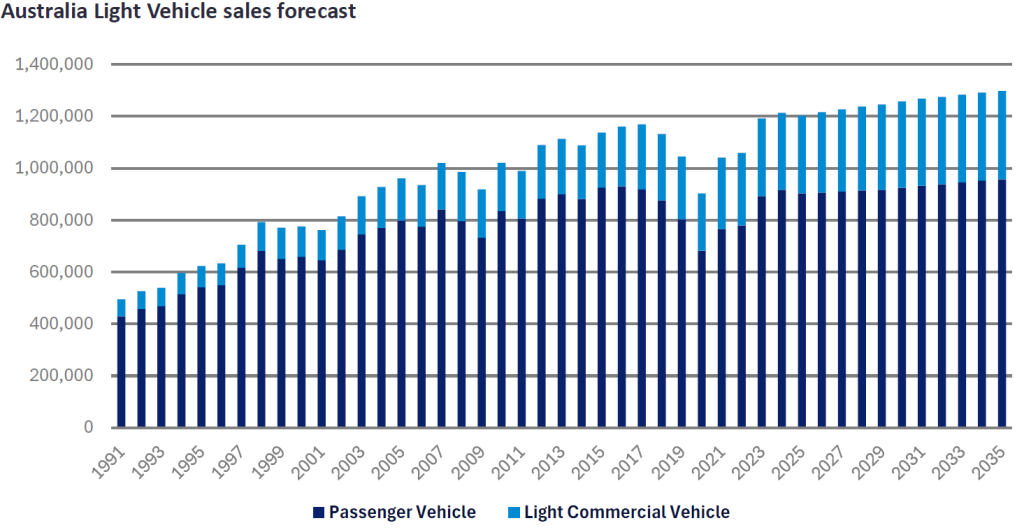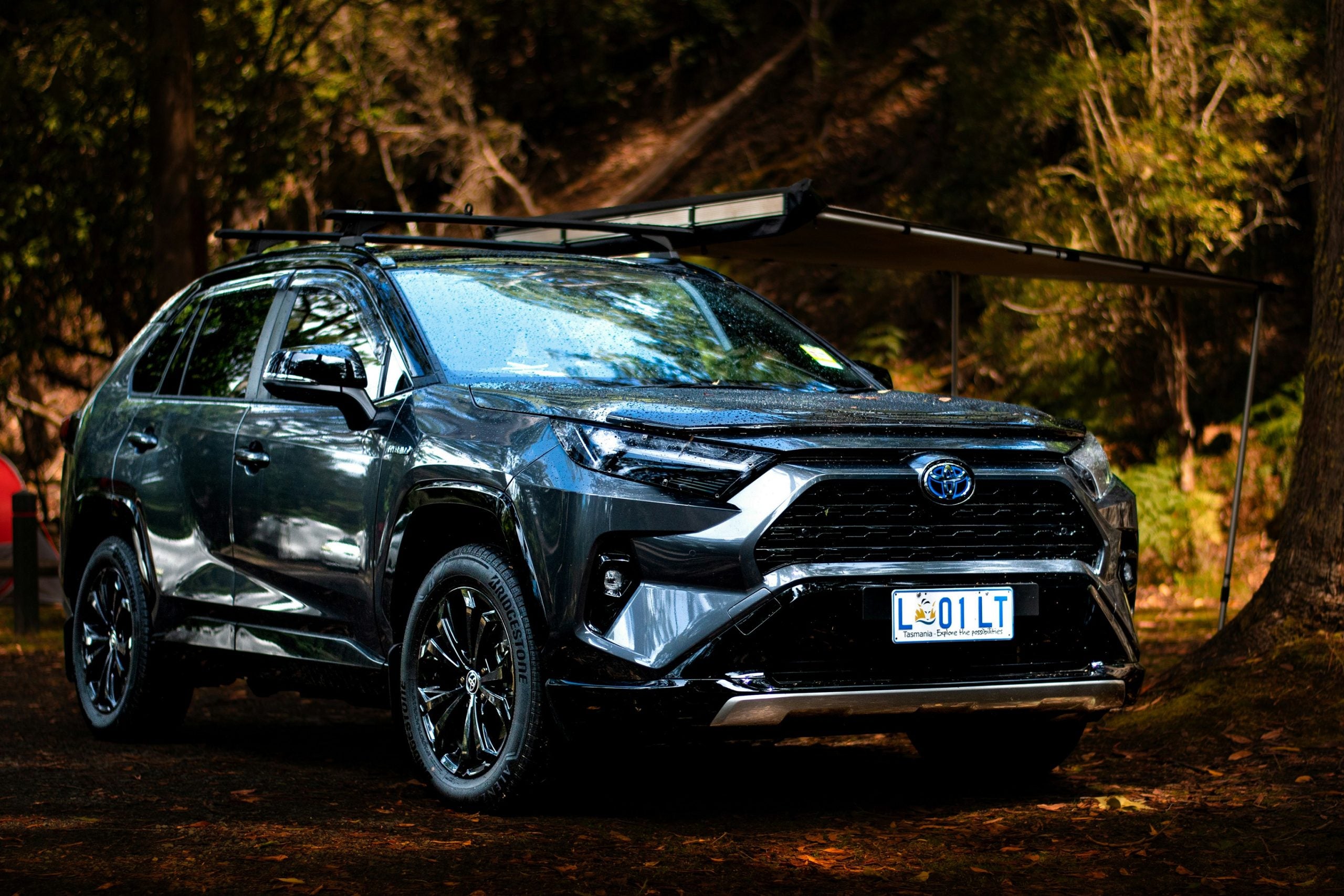2024 was a record-breaking year for the Australian Light Vehicle (LV) market. Total sales in the country reached an all-time high of 1.21 mn units, representing a 1.8% expansion, and surpassed the 1.2 mn-unit mark for the first time in its history. After being impacted by the pandemic and global supply disruptions, the market rebounded strongly and registered record volumes for the second consecutive year.
The stellar performance can be attributed to a catch-up in supply, as well as growing demand for SUVs and Electric Vehicles (EVs). Australia is a 100% import market with no local production taking place since 2017, when the last remaining automakers – GM Holden and Toyota – closed their plants. Their exit came as it was no longer viable to continue local operations due to high manufacturing costs, the small scale of the domestic market, and rising competition from cheaper imported vehicles. Currently, the major suppliers of the country’s new vehicles are Japan, Thailand, Korea, Germany, and, most recently, China.

Australia’s vastness makes vehicle usage almost a necessity, similarly to the US, but the market is totally dependent on imports. During the pandemic, demand surged as consumers rushed to buy new vehicles in order to enjoy domestic travel. This was followed by global supply disruptions after the pandemic, which had a significant impact on LV sales in the country. Moreover, in early 2023, the nation’s ports experienced unprecedented bottlenecks after live insects were discovered in imported vehicles arriving from China. As the insects posed a significant threat to Australia’s agricultural crops, the Department of Agriculture, Fisheries and Forestry started a mandatory “quarantine” (i.e., treatment for biosecurity hazards such as seeds and pests) of each vehicle offloaded from vehicle-carrying ships. This resulted in further delays of deliveries of several weeks. In one instance, a vessel carrying thousands of Tesla models was forced to return to Shanghai after stink bugs were found on board. All of these events culminated in wait times of months, and sometimes years, for many vehicles.
By mid-2023, however, supply constraints started to ease, and sales gained strong momentum, fulfilling a large volume of backlogged orders. By mid-2024, dealers started to report a change in the market, whereby pending orders were being cleared faster than new orders were being received. Showroom traffic slowed and consumers were tightening their spending due to persistently high interest rates and the rising cost of living. According to the Federal Chamber of Automotive Industries (FCAI) – the local industry association – sales by private buyers declined by double digits in the final months of 2024.
The FCAI reports that Toyota remained the best-selling brand in 2024, accounting for almost 20% of the market. Toyota was followed by Ford, with a market share of 8.2%, Mazda at 7.9%, Kia at 6.7%, and Mitsubishi at 6.1%. However, Chinese brands are rapidly making inroads and gaining a strong foothold in the country. This was evident in 2024, as MG and Great Wall Motor (GWM) ranked as the 7th and 10th largest brands. By model, the Ford Ranger, the Toyota RAV4 and the Toyota Hilux were the top-sellers during the year – although the RAV4 (now available only as a hybrid) outsold the Ranger and ascended to the top spot in H2 2024. The MG ZS ranked in 9th position, while Tesla’s sales declined, as only two of its models – the Model 3 and Model Y – were on sale. It is important to note that sales performances in Australia are often influenced by the availability of supply rather than actual demand.
Advance data indicates that sales of xEVs accounted for 28% of total Passenger Vehicle (PV) sales in 2024, with the share of Battery Electric Vehicles (BEVs), Plug-in Hybrids (PHEVs) and Full Hybrids (FHEVs) standing at 8%, 2%, and 14%, respectively. While BEV sales slowed, PHEV and FHEV volumes continued to expand. With an increasing number of Chinese EV brands entering the Australian market, the competition in the xEV sector is set to intensify. The government also introduced the New Vehicle Efficiency Standard (NVES) on January 1, 2025, which is expected to further boost sales of electrified vehicles.

US Tariffs are shifting - will you react or anticipate?
Don’t let policy changes catch you off guard. Stay proactive with real-time data and expert analysis.
By GlobalDataLooking ahead, volumes are forecast to decline marginally to 1.2 mn units in 2025 after two consecutive record-setting years. Downside risks arise from US President Trump’s protectionist trade policies, China’s slowdown, and intensifying global warming. On the other hand, the Reserve Bank of Australia is expected to start to cut interest rates soon, which could help bolster sales.

The country’s medium and long-term sales outlook is generally positive. Sales are projected to remain in the 1.2-1.3 mn unit range over the next decade. Downside risks to the long-term forecast include: a cloudy export outlook due to China’s slowing economy; global warming and its impact on Australia’s farm output; and the aging population.
Australia is a mature market. PV density is at 710 units per 1,000 adults, the highest in Asia. The figure is much higher for LVs as a whole, at 880 units per 1,000 adults – including Light Commercial Vehicles (LCVs) that are comprised mostly of Pickup Trucks, mainly for personal use. The already high density will be a constraint for sales growth in the long term.
As for demography, Australia has an advantage compared to many other advanced economies, as it has relatively high rates of net migration. Nonetheless, the population is aging. People aged 65 and above currently account for 17% of the population and that share is forecast to rise to 20% in 2032. That will also limit the long-term sales growth potential of the automotive sector. On a positive note, the vast continent makes vehicles a necessity and replacement demand will continue to drive the market. In addition, a relatively fast shift to xEVs has, and will, continue to support replacement demand.
Meg Sunako, Senior Analyst, Economics and Topline Forecasts, GlobalData
This article was first published on GlobalData’s dedicated research platform, the Automotive Intelligence Center.




